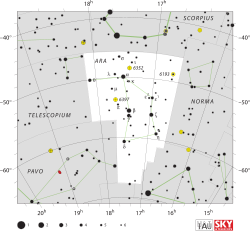Kappa Arae
| Observation data Epoch J2000 Equinox J2000 | |
|---|---|
| Constellation | Ara |
| Right ascension | 17h 26m 00.04169s[1] |
| Declination | –50° 38′ 00.6417″[1] |
| Apparent magnitude (V) | 5.21[2] |
| Characteristics | |
| Spectral type | G8 III[3] |
| B−V color index | +1.05[2] |
| Astrometry | |
| Radial velocity (Rv) | +17.3[4] km/s |
| Proper motion (μ) | RA: +13.45[1] mas/yr Dec.: +8.36[1] mas/yr |
| Parallax (π) | 7.16 ± 0.40 mas[1] |
| Distance | 460 ± 30 ly (140 ± 8 pc) |
| Absolute magnitude (MV) | –0.58[5] |
| Details | |
| Radius | 14[6] R☉ |
| Surface gravity (log g) | 2.3[5] cgs |
| Temperature | 4,950[5] K |
| Metallicity [Fe/H] | –0.3[5] dex |
| Other designations | |
| Database references | |
| SIMBAD | data |
Kappa Arae (κ Ara, κ Arae) is the Bayer designation for a single[8] star in the southern constellation of Ara. Based upon parallax measurements, it is approximately 460 light-years (140 parsecs) distant from Earth, give or take a 30 light-year margin of error.[1] With an apparent visual magnitude of 5.21,[2] this star is faintly visible to the naked eye.
This is a giant star with a stellar classification of G8 III;[3] its outer envelope has expanded to about 14 times the radius of the Sun.[6] It is radiating energy into space at an effective temperature of 4,950 K.[5] This is hot enough for it to shine with the golden-hued glow of a G-type star.[9]
It has two 14th magnitude optical companions that are at an angular distance of 25 and 30 arcseconds.[citation needed]
References
- ^ a b c d e f van Leeuwen, F. (November 2007), "Validation of the new Hipparcos reduction", Astronomy and Astrophysics, 474 (2): 653–664, arXiv:0708.1752, Bibcode:2007A&A...474..653V, doi:10.1051/0004-6361:20078357.
- ^ a b c Corben, P. M.; Stoy, R. H. (1968), "Photoelectric Magnitudes and Colours for Bright Southern Stars", Monthly Notes of the Astronomical Society of Southern Africa, 27: 11, Bibcode:1968MNSSA..27...11C.
- ^ a b Houk, Nancy (1978), Michigan catalogue of two-dimensional spectral types for the HD stars, vol. 2, Ann Arbor: Dept. of Astronomy, University of Michigan, Bibcode:1978mcts.book.....H.
- ^ Evans, D. S. (June 20–24, 1966), Batten, Alan Henry; Heard, John Frederick (eds.), The Revision of the General Catalogue of Radial Velocities, vol. 30, University of Toronto: International Astronomical Union, p. 57, Bibcode:1967IAUS...30...57E.
{{citation}}: Unknown parameter|book-title=ignored (help) - ^ a b c d e Jasniewicz, G.; et al. (February 1999), "Late-type giants with infrared excess. I. Lithium abundances", Astronomy and Astrophysics, 342: 831–838, Bibcode:1999A&A...342..831J
- ^ a b Pasinetti Fracassini, L. E.; et al. (February 2001), "Catalogue of Apparent Diameters and Absolute Radii of Stars (CADARS) - Third edition - Comments and statistics", Astronomy and Astrophysics, 367 (2): 521–524, arXiv:astro-ph/0012289, Bibcode:2001A&A...367..521P, doi:10.1051/0004-6361:20000451.
- ^ "kap Ara". SIMBAD. Centre de données astronomiques de Strasbourg. Retrieved 2010-07-30.
- ^ Eggleton, P. P.; Tokovinin, A. A. (September 2008). "A catalogue of multiplicity among bright stellar systems". Monthly Notices of the Royal Astronomical Society. 389 (2): 869–879. arXiv:0806.2878. Bibcode:2008MNRAS.389..869E. doi:10.1111/j.1365-2966.2008.13596.x.
{{cite journal}}: CS1 maint: unflagged free DOI (link) - ^ "The Colour of Stars", Australia Telescope, Outreach and Education, Commonwealth Scientific and Industrial Research Organisation, December 21, 2004, archived from the original on February 22, 2012, retrieved 2012-01-16.

